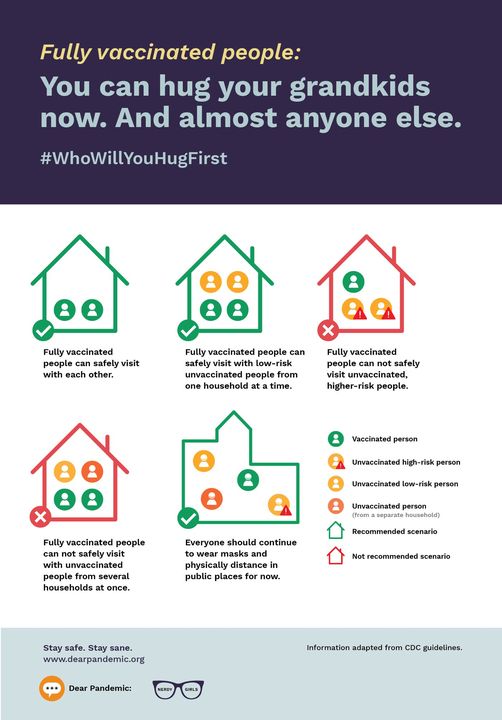*** Edited to clarify that children who have not been vaccinated are considered unvaccinated people under this guidance.***
It’s Good News Tues!
Yesterday, the United States Center for Disease Control and Prevention (CDC) issued new guidelines stating that 👏🏼 fully 👏🏼vaccinated 👏🏼 people can safely:
🌟 Visit other vaccinated people indoors–without wearing masks or physically distancing!
🌟 Visit unvaccinated people–without wearing masks or physical distancing, as long as the unvaccinated people (and the people they live with) are low risk for severe COVID-19!
🌟 Skip quarantine and testing if they are exposed to someone who has COVID-19! But, do monitor for symptoms for 14 days, get tested, and start quarantining if symptoms develop. Remember, symptoms can be all over the map, and might be quite mild (especially after you’ve been vaccinated).
Isn’t this awesome??!!!! Are you thinking about all the people you are going to hug as soon as you are fully vaccinated?! #whowillyouhugfirst
❓ What does fully vaccinated mean?
✔️ 2 weeks following the last dose of your vaccine, you are fully vaccinated. For vaccines that only require one dose, that’s two weeks after the one dose. For vaccines that require two doses, that’s two weeks after the second dose.
❓ Does this mean that fully vaccinated people can get together with also-fully-vaccinated friends indoors, without masks?
✔️ YES. Yes it does. Congratulations. Please keep the invitation list small for now.
❓ Does this mean grandparents can visit unvaccinated children and grandchildren indoors, without masks and distancing?
✔️ YES–with a bit of caution. You can visit with the unvaccinated members of one household at a time, and only if the people you are visiting with–and the other members of their household–are low-risk for severe COVID-19 outcomes.
The unvaccinated members of two *different* households should still not be visiting with one another, or visiting their fully-vaccinated grandparents at the same time. Because they could still give COVID-19 to each other.
Wondering who is at increased risk? This category includes unvaccinated people who are older, pregnant, or who have medical conditions including cancer, chronic kidney disease, COPD or other lung disease, Down Syndrome, heart conditions, obesity, sickle cell disease, smoking, and type 2 diabetes. Check out the whole list.
❓ Does this mean vaccinated individuals definitely cannot spread COVID-19 infection to others?
🤔 We still don’t have a really firm answer here. For weeks, promising reports have been accumulating which indicate vaccinated people are at least much less likely to get infected and spread COVID-19, including without symptoms.
Also, every week, more and more people in the highest risk groups are getting vaccinated, at least in high-income nations. This lowers the chances of really bad outcomes with any transmission from vaccinated people to unvaccinated people. Basically, fewer and fewer people who might end up with severe disease are walking around each day. But, this lingering unknown is why vaccinated people should still take precautions around high-risk people who have not yet been vaccinated, and in public.
❓ Does this mean fully vaccinated people can go out in public with no mask or distancing?
❌ NO. Not yet. CDC is still recommending vaccinated people wear masks and physically distance in public. This makes sense since you can’t necessarily know who is high-risk in settings such as the grocery store. These steps can help protect those around you if you do happen to be infected.
❓ Does this mean fully vaccinated people can attend a large gathering? Karaoke night??
❌ NO. Not yet. CDC recommends vaccinated people still avoid medium- to large-sized gatherings and poorly ventilated spaces, and also continue washing hands, wearing masks and physically distancing in public spaces. This makes sense since we are still trying to meet the goal of reducing overall transmission in the population. Wearing a mask is a signal to other people to wear a mask too.
And also because the rest of us might get really, really jealous.
❓ I’m vaccinated but my children are not. What category do I fall in?
🚸 YOU are fully vaccinated. Your children are not.
Let me repeat that: children who are not fully vaccinated are not fully vaccinated people! As a family, you can visit with 👏🏼 fully 👏🏼 vaccinated 👏🏼 people. Indoors with no masks or distancing. You, the vaccinated adult(s), are fully vaccinated. That means you can visit with either vaccinated people or, if you leave the kids at home, with low-risk unvaccinated people.
Your children could still catch and transmit COVID-19, and so they should NOT be visiting with unvaccinated people without precautions.
❓ What about kidssssss??????
❌Children are people. Most children have not been vaccinated. 👏🏼 All unvaccinated children are unvaccinated people. 👏🏼 Children should NOT be getting together across households without following the #StaySmart guidelines–just like other unvaccinated, non-children people!
As more and more people become fully vaccinated and the rate of cases continues to drop, we expect guidelines around what vaccinated individuals can do in public to start to relax more. Stay tuned and the Nerdy Girls will share updates on this as they become available!
For more information on this new guidance, see links below:
CDC Issues First Set of Guidelines on How Fully Vaccinated People Can Visit Safely with Others
When You’ve Been Fully Vaccinated
CDC Says It’s Safe For Vaccinated People To Do These Activities



